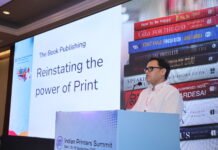
In Ray Bradbury’s 1953 novel Fahrenheit 451, society has turned its back on books, preferring instead easy entertainment such as games and television. To preserve the citizen’s happiness, books have been outlawed with firemen burning any that they find. A resistance movement fights back with each member choosing a book to memorise before they all disappear. The novel was written in response to the censorship of the McCarthy era and yet today books are struggling to survive, much as Bradbury predicted, with a recent survey finding that 25% of all adults in the US did not read a book at all last year, either in print or electronic format.
Nessan Cleary
adly, we live in an age of mass surveillance and indifference, where everything we want can be
delivered on-demand, but mostly we look for simple headlines and soundbites, for ready-cooked meals and cheap thrills. Given falling books sales, it seems that few of us make the time to stop and look at the world around us or to think through the sort of complex issues of who we are and how we live that a good novel can help to unravel. Book printers have responded by embracing digital print technology and recently we’ve been to see one of these in particular, the Timsons T-Print, which was launched at drupa in May 2012.
Engineering tradition
Timsons was founded in 1896 by Arthur Timson, an engineer who
started repairing, and then making, machinery for the shoe industry, which dominated the local area in Kettering, Northamptonshire in the UK where Timsons is based. Today the company is owned by his granddaughter, Jane Timson Brown, though the managing director is Jeff Ward who, like many of the senior management, began his working life as an apprentice for the company.
Timsons moved into printing when a shoe manufacturer asked for a machine to print labels for shoe boxes. It has specialized in book printing machines for the last 40 years, installing some 250 book presses worldwide in that time.
Timson’s still runs its own iron foundry and it’s an impressive sight watching molten iron, which can
reach temperatures of 1500º, being
poured into the moulds. Technical sales director Jon Walker says proudly, “Everything here is manufactured in the UK. We are still a traditional engineering company.” It takes 25,000 man hours to make a conventional press and around 10,000 hours for a digital one.
But these days Walker says that the company mainly exports its products, with an even split between Europe and North America. Timsons has a European sales subsidiary in Milan, Italy, and a sales and service company in Illinois, North America.
Finishing
Timsons has built its reputation with large litho presses but has changed with the time. Walker says, “As run lengths have declined, we have focused on improving makereadies and uptime.” This has led to the zero makeready T48A web press.
By 2008 the company started to look seriously at inkjet, opting initially to concentrate on the finishing side by developing the T-Fold. Walker says, “It’s a loose leaf sheeting and folding system.” It can cope with variable signature sizes and produce a wide range of different book types. This works well with perfect bound books and Timsons has recently developed the concept to further extend the finishing and to work with any type of webfed digital printer.
This was followed by the T-Book, which is an automated solution for producing book blocks. This takes the full web width from the printer and
splits it into four ribbons. Each ribbon has the pages for the book in sequence so they can be cut and stacked together and then glued, producing four book blocks across the width of the machine. The glue is just to hold the blocks together so they can be handled easily until the cover and binding is added. It runs at 650 fpm, or 198 mpm, enough to keep up with digital presses and can produce 4,000 book blocks per hour.
Kodak’s continuous inkjet
Last year Timsons went a step further, collaborating with Kodak to produce a high volume monochrome digital book printer, the T-Print. Walker claims that this is, “the widest, most productive inkjet press to date.” It uses two of the Kodak Stream print lines stitched together to give a width of
1320 mm. It runs at 200 metres per minute at its maximum 600 x 900 dpi and at 300 mpm at 600 x 600 dpi.
Walker says, “We wanted to design a press that could sit alongside our traditional litho presses and not look out of place. It’s capable of running with the same paper stocks as our litho presses because our customers do not want to carry a second inventory for their digital press. And they want to be able to decide late in the day which machine to use based on run lengths and economy.”
For now there’s only one up and running, at Clays in Norfolk, United Kingdom. A second one was installed at the MPG plant in King’s Lynn in the UK but since its insolvency this is now earmarked to be shipped to Bang Printing in Minnesota, USA, early next year. And, of course, there’s a third — at the Timsons’ factory.
Sitting next to the T-Print at the Timsons’ factory was the Prosper 1000 and T-Fold that came out of the now defunct MPG. There’s a useful upgrade path from one to the other. Jeff Edwards, managing director of Timsons, says that it’s down to volume, noting: “The T-Print is for 24 hours non-stop production.” The Prosper 1000 is good for up to 5 million books per year. The T-Print is the best option for 9 million books and over and customers have a choice between 5 to 9 million. Both use exactly the same imaging heads, but the T-print can run faster, up to 300 mpm, thanks to its heavy duty metal frame that damps down vibrations better than the much smaller Prosper. The T-Print also has twice the print width so it’s a considerably more productive machine. In addition, Timsons fits it with a more expensive automated roll changer. The T-print will cost around 3 to 3.5 million including finishing but depending on the configuration, while the Prosper 1000 costs 1.1 million though Erwin Busselot, Kodak’s marketing manager, estimates that with the finishing it will be closer to 1.4 million.
Busselot says that the European market would rather have the smaller Prosper because of the smaller volume. He also says that there’s no need for a wider version of the Prosper because it’s more efficient to increase the speed and add electronic collation than to have a wider machine.
Kodak has been steadily improving its continuous inkjet printers since we
first saw them. The heads now last for an average of 1,200 hours, roughly double that of the first generation, and Busselot says the aim is to reach a lifespan of 2,000 hours. The improvement has come through improving the heads, the inks as well as changes to the maintenance regime and better training for operators.
Kodak refurbishes the heads and returns them to customers, many of whom may not have realized that Kodak has updated their heads so that most customers are now running fifth generation printheads.
Kodak has also improved the profiles that it makes so that it’s easier for customers to experiment with the amount of ink used — reducing ink affects the optical density but can lead to considerable savings per job. Busselot says there are subtle differences between markets, noting that UK customers are very cost efficient whereas in France image quality is more important. Kodak has had quite a lot of success with the mono Prosper, and Busselot says that mono is acceptable in the European book market whereas color is preferred in North America. Color is a harder sell, partly because few other applications outside of direct mail have the volume necessary to justify the cost.
Busselot says that there can be considerable differences between paper grades, even for the same type of paper: “We have seen that we can reduce the ink levels by 20 to 30% and still get a sharp image. So it’s important to get the right grade of
paper as you can get a better image and a lower ink consumption by choosing paper grades carefully.” Although the Prosper 1000 is a monochrome press, it has a modular design so that it can be field upgraded to a full Prosper 5000 color press.
Publishing market
Busselot notes that for most book publishers 80% of their revenue comes from 20% of the titles, meaning that they have to find a cost effective way of producing the other 80% in shorter run lengths. This has meant that most publishers have moved away from the speculative inventory model of printing many copies and warehousing them, in favour of shorter runs as needed. He
says that 60% of all books now have run lengths less than 1,000.
In part, this is down to the growth of digital editions. eBooks now account for 30% of the US market although the American Publishers Association shows a decline in eBook sales. In contrast, eBooks account for 10% of the UK market.
However, Busselot argues that the book industry as a whole is shrinking. There has been consolidation amongst publishers while at the same time there are fewer book stores and those that remain have diversified into selling other things.
But there are some bright spots. Belgian researchers at Hasselt and Antwerp University have found that people buy more romantic fiction if the shop smells of chocolate. Many books are sold as gifts so some book shops prefer to stock attractive deluxe editions.
In addition, publishers have sought to exploit the digital nature of book technology. In some cases this has meant personalizing the cover or addressing the foreword to a named person. In France, Editions Comédia has a scheme for completely personalizing a story to one reader — customers fill in a form with someone’s personal details and these are then woven into the storyline, which makes for a unique gift. Other books have used QR codes and augmented reality to take readers to dedicated online sites.
So, join the resistance, fight back and read a book today, but preferably after you’ve finished reading Indian
Printer and Publisher












